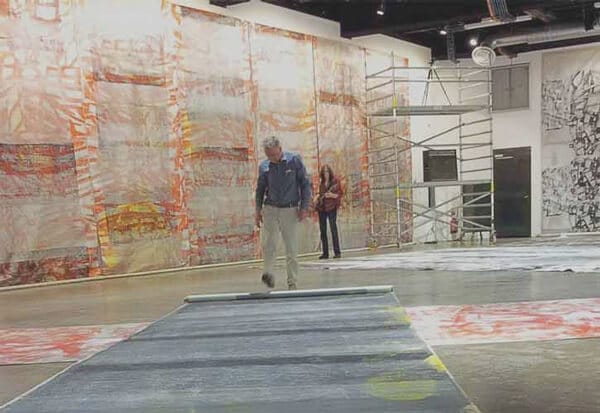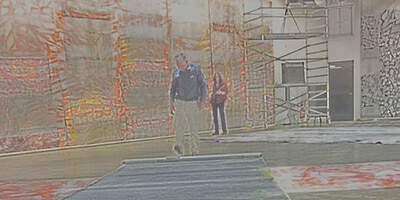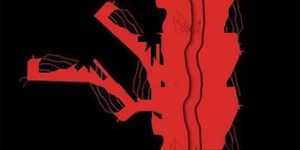The work of Bernard Bousquet, plastic surgeon, crosses my concerns.
His deliberately anti-spectacular personality, too. A secret man, he confides in himself with suspicion and circumspection. The result of his creation, both gigantic and measured, proves him right, especially in these times of unpacking, when the media often take over the hollow resonance. Bernard Bousquet's work, a word used here for lack of a better one because it is no mystery not to love him, is methodical and scrupulous. The technique of silkscreen printing imposes it and perfectly serves his temperament and his quest as an artist. It brings him efficiency, legibility, amplitude and details.
I enjoy writing this article as much as I enjoyed attending the opening. The immense rolls of canvas, printed as the frames are repeatedly positioned, stretched with silk and inked, remain in memory and in turn imprint the retina and the imagination of a glorious landscape.
Something chivalrous and heraldic inhabits the space thus adorned. As much paintings as stage coats, the immense trains give theprinting of deep, ingrained luxury, or rather, inked in history.
Bernard's paintings could perfectly wrap the bodies of the protagonists of the coronation of a sumptuously dressed Boris Godounov.
Textiles, patterns, colours and wefts do not imply anything of the mannerism often associated with clothing. The rendering preserves the raw character of the canvas which breathes and leads to refinement, not by the concern of a "licked" line, but by the thought that precedes it. The notion of concept is palpable here, but never didactic, because it is "simply" transcribed through its implementation. Impact and economy (in the sense of minimizing the number of gestures by a technique of chain reproduction) are the qualities developed by the entrepreneur or industrialist. Of the latter, with whom he shares life experience and know-how, Bernard Bousquet maintains in his pictorial practice the search for a method combining controlled singularity and intensive production. A perfectly successful cocktail in his case, where intelligence and calculation are not opposed to emotion, but on the contrary, generate the beauty of the works.
The part devoted to "automation" is particularly accurate and directly links the painting to the performance. As a result, the abstraction of repeated motifs does not lead to a cold concept that would be defended solely for its own sake. Bernard Bousquet's painting is profoundly human and makes one want to be "borrowed", like paths on which one would like to walk following the infinite unfolding of the canvas. He does not deprive himself of this and, with a clear sense of purpose, shows us this mental path, even if we will be careful not to follow his footsteps on the strips unrolled on the ground, any more than we will cling, other than mentally, to the virtual meshes and scaffolding falling from the sky along the walls of the Generator.
Here the hook is important and is also simple and effective. Held in height by magnets on metal bars or, as said before, naturally placed on the ground, the lengths of canvases are spread out according to the implicit movement of their support. Here too, no mannerism, nor forced enclosure by the frame, is simply absent. The frame, if there is one, lies between our minds and the flat surfaces of the building that houses them. It is therefore not an ordinary exhibition, but an installation of paintings that invites the movement of the body and the eye between its great alleys.
We thought that once the shock of gigantism had passed - but it doesn't pass - we'd rediscovered the sensation of a museum stroll. There comes the moment, the moments, since there will be two of them during the evening, when human mobility will once again become part of the landscape. Jean-François Pauvros grabs his guitar connected to a powerful amp in a corner of the room and starts to play improvised sounds that fill the place. We then have a better idea of what we had identified without really measuring its presence. Several sound sources distil from the beginning, the variations of their waves via devices hidden in black steel cabinets, also made by Bernard Bousquet. In each one, a guitar and a small amp face each other and interact live, delivering different continuous low frequency feedback, making you feel dense and deep vibrations, but soft, non-voluntary; non-aggressive to the eardrums. The musician's active guitar takes over and Bernard comes to life. With a simple gesture and a sober, non-demonstrative step, he pulls and slides, rolls, transports and unrolls to another place; turns the rolls of canvas.
Visitors spontaneously position themselves as performance or theatre audiences. Once again, the simplicity and efficiency of the act seize us. Surprise and pleasure come again to punctuate the moment.
The canvases had a back. We could have imagined it; we didn't even think it. Reverse. New exhibition on the floor.
As a result, the global environment, by reaction, is changed. Nothing anecdotal; on the contrary, the gesture is important and loads the "spectacle" with a particular emotion, rare on stage, by its magnitude and the minute but precise nature of the concrete gesture. What could be simpler than turning over a surface of fabric? By this very fact, the event is beautiful, memorable, memorable. In fact, many guests grab their phones to capture the scene. We wish it would last longer, but here again, the instinctive calculation is impeccable. Just enough for time to hang on and stay at the degree to which the duo brings it. The evening can go on.
Anne Dreyfus informs us that there will be a second reversal later. We are delighted because the atmosphere has been metamorphosed, stabilized at a level of mental and therefore physical pleasure, which clearly indicates the level of artistic exigency of what is happening. Acting artistically is simple and strong; that's what it tells us intimately. Still, we must not hesitate to perform the act; to do what we have said we would do, without more, nor less; without prevarication, speeches, nor commentary.
Bernard's physical gait is a pleasure to see. It is a beautiful stage act, one of those sought after in performance; simple and true.
Not being in any way an actor, it probably costs him to show himself in a way other than through his plastic creations. You can feel it, but that's good. It is all the quality and the stake of a real gesture and not wrapped in a factitious one.
All that remains is to talk about this duo of clowns, in the very noble sense of the word.
If I sum up the course of the vernissage through my perception, I entered the main hall of a medieval castle whose walls and floor were warmed with grandiose tapestries as furniture, as was the custom. I followed the adventure along the meanders of a contemporary Bayeux Tapestry, where an indecipherable Queen Mathilde and her conqueror William, parade their exploits in a swarming writing of lines crushed by giant abstract or cabalistic logos. I read, between its full and unbounded lines, the narration of the path of a thought that does not want to owe anything to the heaviness of the "saying" of oneself, of others or even of the tangible world that surrounds us. Then, the movement invited itself then, recalling that painting was an activity impressed by both spirit and physicality and that only the vibratory nature of its signs (apparently illustrative whatever the style) was its subject. Then, more than movement, displacement took shape out of the rhythm of electrified, torn and bumpy sounds.
The calm that never evacuated the place, however, came back denser, stronger. It was in Bernard Bousquet's body that it reigned and gave the measure of what was to happen tonight.
His walk and his operative movements have left a mark on me. I remembered imprecise black and white photographs in my memory, in which an artist deliberately surveys the width of a vast space. This gesture seems made for itself. The man is upright and dressed with the normal elegance of the 50s and 60s, which gives all the singularity of this period. Modernity: even if the word seems obsolete, it draws all its strength from the frequent and natural concomitance in those years between the sharp thinking of a contemporary artist and his appearance as a Western man, well dressed, in a shirt or suit jacket. An uprightness that tells the context as much as the spirit. Fluxus, John Cage, Yves Klein or a less well-known artistic entity... I don't know anymore. Still, Bernard Bousquet's body, gestures and attire as a contemporary artist are not insignificant. They are elements which, without artifice, also sign his work in a striking way and in the true wake of the performance.

So I come back to what I described above as the duo of clowns between Bernard Bousquet and Jean-François Pauvros. On one side, the White, straight and clearly drawn; on the other, the Auguste, furiously gnarled and with a colourful soul. The body of Jean-François Pauvros, for those who have seen it, is also obviously notorious. Long wrought-iron bishop's crook, its disproportionate stature in proportion to its thinness, arches at the top to shelter under a dense curly hair, which seems to fray into wire with inextricable beards clinging to the space. Like an open and highly uttered claim, large glasses and a shirt with loose sides are used to refine the sculpture. The rock of the 70s emanates from his silhouette outside the sound of his virtuoso guitar that one feels very free; easy and light as a child's toy in his hands. In front of this slender body with wader legs, one cannot help but think of Giacometti's gaunt figures. The entrepreneur and the rocker combine with them an additional test of The man who walks from 1960.
Painting is not forgotten for all that. There would still be much to say about the duplication in Bernard Bousquet's plastic work and his hidden portraits. Initiates will be able to search in the interlacing of signs, those, perfectly readable in fragments, reproducing the school homework of his daughter, Irene, or others more imbedded in the material, coming from the slow combustion of the clothing effects of his entourage. So many prints modestly taken, discovered and then covered as he does when he returns to view his works. Perhaps, in both of them, we should see frail testimonies of the passing of time; to the chandeliers of the noisy landscape photographer or portrait painter who pretends to capture the moment, when, in most cases, it only reveals to us the crushing of the artist under that fraction of uselessness that he was unable to grasp. Melancholy of an author, but not total abdication in the face of the excessiveness imposed on us by the temporal unfolding that mocks our existence.
Several seconds after they were pulled on the ground, I saw the patterns of the canvas ribbons continue to advance. With my eye most likely failing, I kept the undulating image of the dried skin of a giant skinned python that would be unfurled in front of the tourist, a potential buyer, by an African merchant.
Without breaking a sweat, Bernard Bousquet would wet his shirt and enjoy, perhaps unconsciously, an art market where the works would benefit from being taken out of the frames and piled up before the eyes of onlookers, whether connoisseurs or ignorant.
In the legs of a boatman with a body without exteriorization of moods and an impassive face like Buster Keaton; in a one-night stand, with Jean-François Pauvros, seriously burlesque, evoking the mechanized dance of Gilbert and Georges, Bernard Bousquet uses his body behind the effacement of a restrained class and without visible emotion. In doing so, he discreetly and unknowingly places us in his space, as models whose ephemeral traces he transfigures into signs, making us walk the paths that he decides to create between his canvases. At least we can imagine him.
Evolving along the extended forms that have become inert again, the music having again become duller, I take pleasure in realizing that at the antipodes of drawing and manual tracing, Bernard's apparent painting presents a background project, photographic and chromatic, whose very lively dynamics are elaborated in an incredibly rich and vivacious way under the complexity of the layers. Such apparent simplicity at the service of a rigor that is in reality very much maintained in the presentation of the works, obviously joins the claim of idleness which he likes to mischievously affix to himself, to define Bernard Bousquet as an aristocrat of art, in the most beautiful elegance of the acceptance of the term.
Thus, The Generator continues to write its history of immediacy in, on and within its walls.










